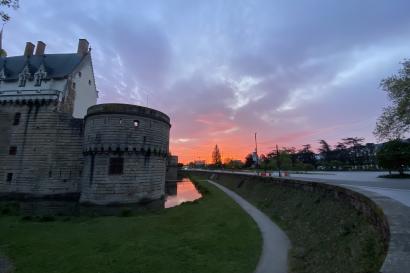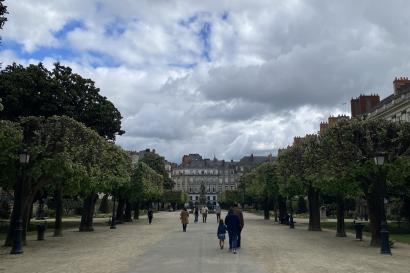I got my second keychain two Saturdays ago at a large tourist stop on the road to Guérande, a fortified medieval town. We stopped there because the host mom (mère d’accueil) of another IES Abroad student was taking several of us there and wanted to stop on the way to show us the salt farms, a vast expanse of marshy earth spreading out on either side of the narrow road all the way to the skyline of the town by the sea, dominated by a church’s tall, blocky tower. The salt farms themselves were shallow square pools filled with seawater, evaporation causing thin crusts of salt to form around the edges.
“Rain is disastrous because then there is no evaporation, and no salt,” the mère d’accueil told us. She showed us around the pools, pointing out the channels that allowed seawater in. “They harvest the salt using wheelbarrows. It used to be that was difficult, because the old tires were too heavy and made the paths collapse.” These dirt paths outlined every pool, rising barely above the water and sprouting green things. “Then the rubber tire was invented, so that’s not a problem anymore.”
Then we visited the tourist stop where I got my keychain. Everything in there had something to do with the salt of Guérande: salt flour, chocolate with salt, fancy aromatic salts, keychains with wheelbarrows full of salt on them.
Afterwards we drove up the road, the Église Saint-Guénolé’s tower growing larger the closer we got, until the mère d’accueil parked directly in its shadow.
“If you go give the woman in the booth two euros,” she said, “you can climb the tower.”
We paid the two euros and headed in through a small turquoise door. That staircase had to be one of the most wonderful things I’ve seen in my life—clearly about a million years old, narrow, made of stone, a spiral wound so tightly I couldn’t see around the corners, the stone just above my head ribbed with the outline of the steps above me, tiny rectangular windows cut into the walls to provide bite-sized views of the blue-roofed houses growing smaller and smaller beneath me. I finally reached the top, which was high enough to make my stomach fall through my toes. Over the old stone railing was a spectacular view: the flashing green cross of a pharmacie shrunk to the size of a fingernail, little houses bleeding into the silver sea, and in front of me the marshy salt farms stretching back along the road we drove to get here. The wind hissed over bumpy gargoyles turned faceless by age and through my hair—for all that, I would’ve paid more than two euros.
The following Saturday, I went on the IES Abroad trip to Mont St Michel and St Malo. The drive to Mont St Michel took three hours by bus, so we had to leave Nantes when it was still dark outside. About two hours in we drove through a patch of heavy rain, which made me nervous since I’d forgotten my umbrella at home, but thankfully the storm passed. Towards the end of the trip we drove through an old little village, then past fields of sheep and cows, and then the bus took a turn and there was Mont St Michel.
From a distance it was striking—a sudden burst of height on a flat horizon, walls the color of sunlight, narrowing into the hair-thin figure of the Archangel Michael at its top. The closer we got, the more details appeared. I could see streets and houses winding up to the abbey and the intricate designs of the arched windows. Finally we were at the entrance, surrounded by damp sand that we were strictly forbidden to touch because there was a danger of quicksand. The first thing we did was walk through the town and directly up to the abbey, passing dozens of souvenir shops and restaurants, until each curve of the road meant that I was above another layer of tiled roofs.
One of the first parts of our tour led us onto a large balcony looking out over the land surrounding Mont St Michel. There was a seagull hovering just off the right-hand side wall, flying against the wind and completely unaware of everyone taking pictures of it, the view, and the ornately-carved spires of the abbey. Inside, the abbey was an endless labyrinth of stone rooms. The stained-glass windows didn’t depict Biblical scenes or saints like in the other churches I’ve seen so far--instead they were made of various shapes of pastel-colored glass fit together in simple geometrical patterns. There was a crypt, a gift shop, rooms devoted to prayer, work, worship, and various saints; green gardens wrapped with delicate stone pillars, and out of every window a view of damp sand studded with ponds like silver coins, larger stretches of water rippling with odd currents that threw up foam, distant sheep-filled fields, and a blue sky that ended at lines of trees or tiny houses on the horizon.
After lunch and the purchase of another keychain, it was back on the bus for an hour to the walled seaside town of Saint Malo. Most of the ramparts and town were destroyed by bombings during World War II, but they were rebuilt to be historically accurate. It was cold and unmercifully windy—weather I love. A group of us walked across the beach and down a path to an little island. On the far side was a grave with a nearby inscription declaring that it was a great French writer’s request to be buried here by the sea. I Googled it later—that was Chateaubriand’s grave. Forty minutes later on the ramparts, one of my companions pointed out that the path to the island had been covered by high tide. By the time we returned to Nantes, it was dark again—but that trip was worth waking up for.

Suzan Frierson
<p>Hi! My name is Suzan Frierson and I'm a junior at the University of Redlands. I'm a Creative Writing major and French minor, and the language inspired me to study abroad in Nantes. I love traveling, writing, and going on adventures.</p>








